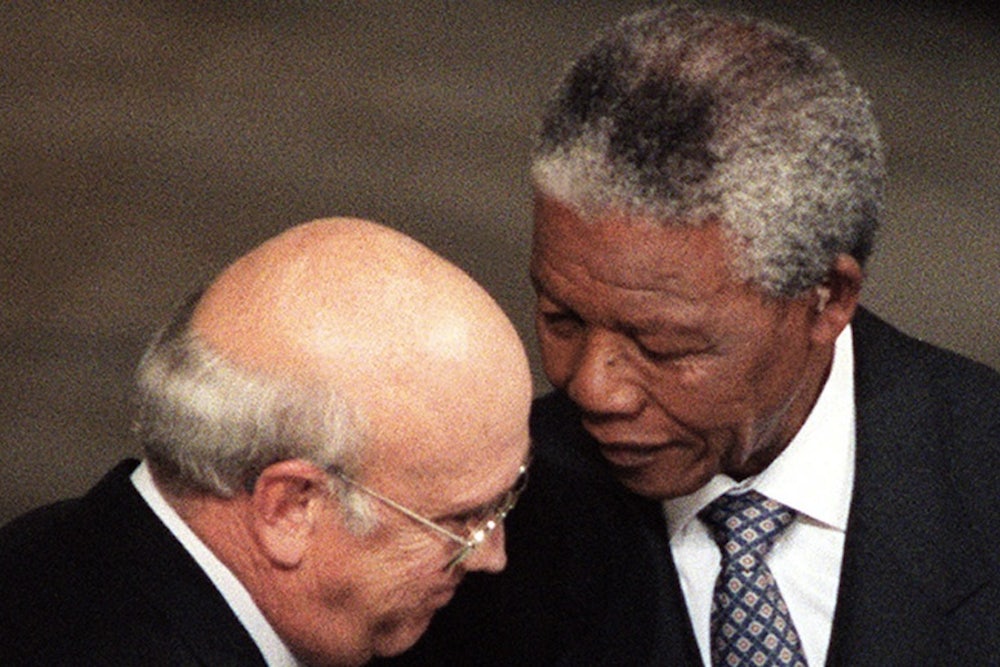Throughout the 1980s, the relationship between the African National Congress and the South African government was marked by mutual antagonism and distrust, but by 1993, former rivals Nelson Mandela and F. W. de Klerk were embracing over a shared Nobel Peace Prize as South Africa prepared for its first fully democratic elections. The negotiations between Mandela and the South African leaders presiding over Apartheid are remarkable not only because they changed the social and political landscape of South Africa, but because they provide an example of peaceful diplomatic negotiation succeeding where violence seemed inevitable.
In the journal International Negotiation, Mark Young of Humboldt University of Berlin analyzed this “negotiation miracle” in terms of the “Red/Blue game,” a version of the Prisoner’s Dilemma first conceived by the U.S. military during the Korean War which has become a classic exercise in negotiation training.
In the “Red/Blue” game, players are divided into two teams. The teams are sequestered in separate rooms and forbidden from communicating with each other. With the goal of accumulating as many points as possible, each team must select "Red" or "Blue":
Over ten rounds, [the teams] must each (independently) reach a decision to play a certain move or color: Red or Blue. Points are awarded to both teams at the end of each round depending on what they have both chosen to play… if both teams choose to play ‘Red,’ they each receive three points: if they both choose to play ‘Blue,’ they each lose three points. If the colors are different, the team choosing ‘Red’ loses six points, and the team choosing ‘Blue’ wins six points.
In other words, both teams know they would gain by choosing red, and that choosing blue, while offering the most potential gain, also carries a much greater risk.
From 1976 to 1989, in Young’s analysis, the relationship between the South African government and opposition parties like the ANC can be understood as a “Blue/Blue” game: “In separate bids to defy interdependence and to win the game on its own terms, each side sought to express and increase its power by means of threats intimidations and real damage inflicted on the other side.”
The government instigated the “Blue/Blue” cycle in 1976, when it responded to demonstrations against the compulsory teaching of Afrikaans in schools by massacring hundreds of protestors in Soweto. In a retaliatory “Blue” play, the ANC recruited 14,000 militants willing to die for the sake of overthrowing the Apartheid government. The “Blue/Blue” pattern continued largely uninterrupted for 13 years: By 1989, 4,000 anti-government protestors had been killed and Mandela had spent 27 years in prison; the ANC, for its part, had organized mass protests including school boycotts and orchestrated “necklacing” attacks against opponents. Although this was, overall, a “Blue” period, each side made some small “Red” concessions—like Mandela teaching himself Afrikaans in prison, and the government allowing prisoners access to newspapers.
According to Young, it was external "players" who finally broke the cycle:
In the face of all these Blue moves by the main protagonists in this conflict, it was up to other parties to act to change the rules of the game. This was done first of all by the business community, led by the Anglo-American Corporation, which in September 1985 had taken the fairly courageous Red step of initiating its own set of parallel negotiations with the ANC, calling a secret meeting in the Zambian bush. Further informal negotiation efforts followed by various academic and business opinion leaders… Back channel negotiations changed the tenor of the discussions, with the Red moves of the parallel participants slowly crowding out the Blue behavior of the main protagonists.
The release of Mandela in 1990 signaled a change in tide, with a “Red/Red” cycle beginning to take hold: “As formal negotiations for a new Constitution commenced following Mandela’s release, the Red cycle gathered force, with increasingly bold Red moves taken on each side as ‘talks were held about talks’ and trust was built. Transcending old strategies of tit-for-tat, the two sides began to invest consciously in the process.” At the same time, however, each side continued to occasionally play “Blue” moves, like the government’s financially backing a violent “Third Force” and Mandela publicly calling de Klerk a murderer. Young terms this phase, in the early 1990s, a “purple success”: “It was the mixed use of both [Red and Blue moves] that led to the breakthrough, with Red predominating but with Blue never quite out of sight.”
So what lessons can modern peace-makers draw from the Mandela-de Klerk talks?
- “The best strategy for effective negotiation…is probably a judicious mix of Red and Blue, with the former predominating, but the latter also kicking in occasionally to give each partner bite and to keep the other honest.”
- “Playing Red can be powerful in itself. Far from being a sign of weakness or naïveté, playing Red can literally shame the opponent into reciprocity, at least making them feel silly continuing to play Blue.”
- “Personal bonds and relationships are helpful but not essential….The personal chemistry between Mandela and De Klerk was never very strong and…deteriorated markedly in the course of the negotiations…but what counted in the end was the substance of the agreement, not the degree of good feeling between the protagonists.”
